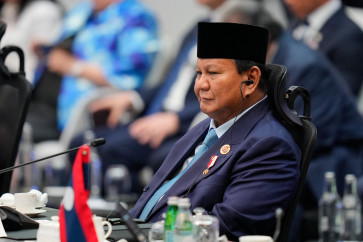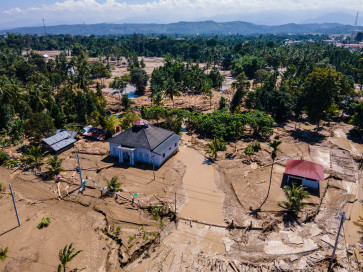Popular Reads
Top Results
Can't find what you're looking for?
View all search resultsPopular Reads
Top Results
Can't find what you're looking for?
View all search resultsThe Indonesian cost of Chinese palm oil
Cutting short his visit to America, President Joko âJokowiâ Widodo recently returned home in a puff of smoke â to tend the fires raging across Indonesia
Change text size
Gift Premium Articles
to Anyone
C
utting short his visit to America, President Joko 'Jokowi' Widodo recently returned home in a puff of smoke ' to tend the fires raging across Indonesia. Most of the fires are man-made, for the purpose of clearing ground to sow palm oil, a US$18 billion industry.
The health impacts of peat-fire pollution, floating over Sumatra, across Malaysia and Singapore, are significant: Presently more than 120,000 people are seeking medical help for haze and smoke in Indonesia alone.
Medical costs are difficult to calculate at this point. But in 1997, another year of major haze, forest fires in Indonesia exacted a short-term economic impact across the three countries of around $1.4 billion from air-pollution-related health costs.
Deforestation today plants the economic blight of tomorrow. From 2000 to 2010, Indonesia saw its forests diminish by 500,000 hectares each year. 41 percent of Indonesia's remaining forest land is considered degraded.
In 2010 the Norwegian and Indonesian governments signed an agreement, whereby the latter would institute a two-year moratorium on permits to log or set up palm oil plantation in government-managed forest and peat lands. As part of this agreement, Norway helps build institutional capacity for improved forest management and, if deforestation rates decrease, Indonesia will receive up to $1 billion.
Seeming to honor its agreement, the Indonesian government has opened 244 cases against illegal peat-burnings; is investigating 16 palm oil companies for their involvement; and recently extended its moratorium on forestry ministry licensing of peatland areas.
But the Jokowi administration has acted ambivalently with regards to peat-for-palm arson in the past, and there's reason to doubt its present investigations will reach their conclusions.
In May 2011 the Norwegian moratorium was brought into effect. However, it contained numerous exemptions as a result of business lobbying. Projects whose applications were received prior to the presidential instruction can still proceed, as can projects related to mining.
In 2013 the Indonesian government proposed six million hectares of degraded land (an area larger than the Indonesian province of Aceh) that could be used for oil palm expansion ' enough to achieve the country's national target of doubling palm oil production by 2020 without additional deforestation.
In August the signees of the Indonesia Palm Oil Pledge (IPOP), which committed producers to industry-leading sustainability practices, were advised by the government to exempt small stakeholders from greener standards.
Musdhalifah Machmud, deputy minister for food and agriculture at the coordinating ministry for economic affairs, said: 'Oil palm plantations are the livelihoods of many of our people. The most effective driver of economic growth is through palm oil plantations.'
And San Afri Awang of the Forest Ministry said that companies have suffered as a consequence of following IPOP. Palm oil production will continue so long as palm oil is demanded.
The question isn't why Indonesia continues to tacitly back peat-burnings, in spite of their grievous human and environmental toll. The question is how Indonesia can wean itself from palm-production dependency when no other industry is positioned to replace it.
Probably it can't ' not by itself at least.
Demand for palm oil is global, so the pressures exerted to reduce demand must be global as well. Bizarrely, China and India ' which account for 45 percent of global palm oil imports ' have eluded global accountability, as if smoke-screened. Indonesia meanwhile is continually expected to foot the majority of compliance costs for transnational haze damages.
It is difficult to implicate someone morally by their purchasing habits.
But China and India's absence in recent haze-related news is conspicuous. In the face of their own increasingly dire environmental circumstances, China and India have been forced to limit their expansion of agriculture.
As a result, they are relying more upon imports, and, by extension, exporting their deforestation 'needs'.
China, for example, plans to further increase its official forest cover to 23 percent by 2020 and 26 percent by 2050.
A major component of this increase will be plantations to fulfill the growing demands of China's economy. But given the central government's commitment to reversing deforestation, it is unlikely that domestic supply will keep apace of domestic demand. Indeed, it is likely that the recent 'exportation' of China's deforestation problems to its neighbors, including Indonesia, will escalate.
So while the twin issues of deforestation and haze wrought by peat-fires and palm-planting continue to be the subject of numerous legislations and regulations in Indonesia, these have largely failed not just by the supposedly rapacious whims of local authorities.
They have failed because demand for palm oil continues to escalate abroad, adding incentive to burn. They have failed because poor air quality in Singapore lies outside the political compass of an Indonesian politician representing impoverished regions where there are many pressures for land clearing, not all of them home-grown.
The dangers of deforestation cannot be overstated. But Indonesia's culpability can. Sanctimony condemning the 'small stakeholders' of Sumatra and Kalimantan should consider the outside forces encouraging this burning.
The pall of smoke spreading across Southeast Asia, towards China and India, has perhaps assumed a symbolic meaning as well. Complicity.
______________________________
The writer is ERIA senior energy economist.










